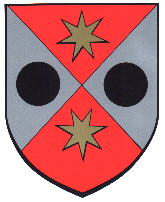Erpeldange: Difference between revisions
Knorrepoes (talk | contribs) m (Text replace - "'''Origin/meaning:'''<br> " to "====Origin/meaning==== ") |
Knorrepoes (talk | contribs) m (Text replace - "[[Literature" to "{{media}} [[Literature") |
||
| Line 17: | Line 17: | ||
The stars are derived from the arms of Baron du Prel, who acquired Erpeldange in 1691 through his marriage with Marie de Failly, descendant of the Gondersdorf family. | The stars are derived from the arms of Baron du Prel, who acquired Erpeldange in 1691 through his marriage with Marie de Failly, descendant of the Gondersdorf family. | ||
{{media}} | |||
[[Literature]] : Loutsch, J-C. et al.; Armorial communal du Grand-Duché de Luxembourg, Fisch, Luxembourg, 1989, 331 p. | [[Literature]] : Loutsch, J-C. et al.; Armorial communal du Grand-Duché de Luxembourg, Fisch, Luxembourg, 1989, 331 p. | ||
Revision as of 21:17, 8 July 2014
| Heraldry of the World Civic heraldry of Luxembourg |
ERPELDANGE
Origin/meaning
The arms were granted on September 21, 1978.
The arms are derived from elements from the arms of several families. The division of the shield is taken from the arms of Frédéric and Gérard of Erpeldange in the 13th century, who used a St. Andrew's cross in their arms.
The roundels are taken from the arms of the Gondersdorf family, who used 5 black roundels on two bars. The Gondersdorf family ruled Erpeldange from 1464-1691.
The stars are derived from the arms of Baron du Prel, who acquired Erpeldange in 1691 through his marriage with Marie de Failly, descendant of the Gondersdorf family.
Contact and Support
Partners:
Your logo here ?
Contact us
© since 1995, Heraldry of the World, Ralf Hartemink 
Index of the site
Literature : Loutsch, J-C. et al.; Armorial communal du Grand-Duché de Luxembourg, Fisch, Luxembourg, 1989, 331 p.











